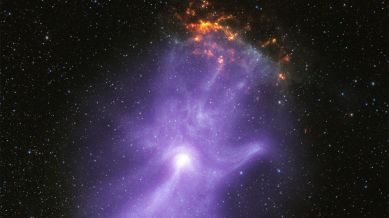NASA celebrated Halloween by sharing this X-ray image of a ghostly cosmic hand thousands of light-years away from our planet.

Halloween 2023: It is Halloween tonight, and while you might catch a glimpse of a few ghosts on your street, none of them are real. But scientists have used two X-ray telescopes to reveal the “bones” of a hand-shaped structure in space. This hand-shaped structure reveals the behaviour of an actual ghost—a dead collapsed star that lives on in the form of plumes of energised matter and antimatter.
This is how the ghost came to be. Around 1,500 years ago, a massive star in our galaxy ran out of nuclear fuel. And then, it collapsed onto itself, in the process forming an extremely dense object called a neutron star.
You have exhausted your
monthly limit of free stories.
Read more stories for free
with an Express account.
Continue reading this and other premium stories with an Express subscription.
This premium article is free for now.
Register to read more free stories and access offers from partners.
Continue reading this and other premium stories with an Express subscription.
This content is exclusive for our subscribers.
Subscribe now to get unlimited access to The Indian Express exclusive and premium stories.
Neutron stars that rotate with strong magnetic fields are called pulsars, and they act as a sort of laboratory for extreme physics. This is because they host conditions that simply cannot be replicated on Earth. Young pulsars sometimes create jets of matter and antimatter that move away from their poles, along with an intense “wind,” creating what is known as a “pulsar wind nebula.”
Most Read
NASA’s Chandra X-ray Observatory first observed this pulsar with a wind nebula shaped like a human hand—labelled PSR B1509-58—in 2001. The pulsar itself is at the base of the “palm” of this ghostly celestial hand. The pulsar wind nebula is called MSH 15-52 and is located about 16,000 light-years away from our planet.
Scientists then used NASA’s newest X-ray telescope— the Imaging X-ray Polarimetry Explorer or IXPE—to look at MSH 15-52 for about 17 days. According to the space agency, that is the longest it has looked at any single object since it launched in December 2021.
An interesting feature of the “hand nebula” revealed by IXPE is the bright X-ray jet directed from its “wrist” to the bottom of the image. Data from the telescope reveals that the polarisation at the start of the jet. But by the end, its polarisation appears to be much larger. This is likely because there are many tangled magnetic fields at the beginning due to the turbulence in the region.
© IE Online Media Services Pvt Ltd
First published on: 31-10-2023 at 2:54 PM IST





